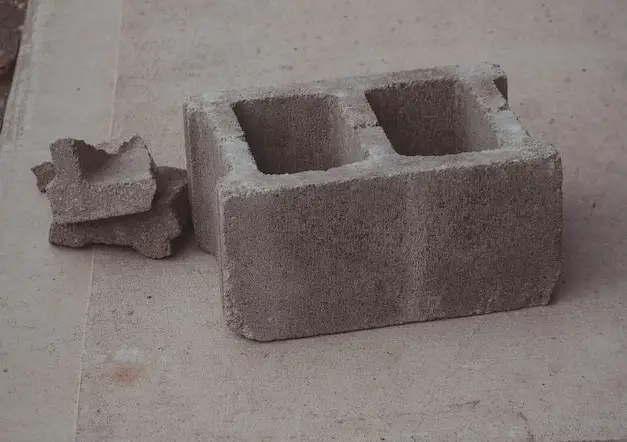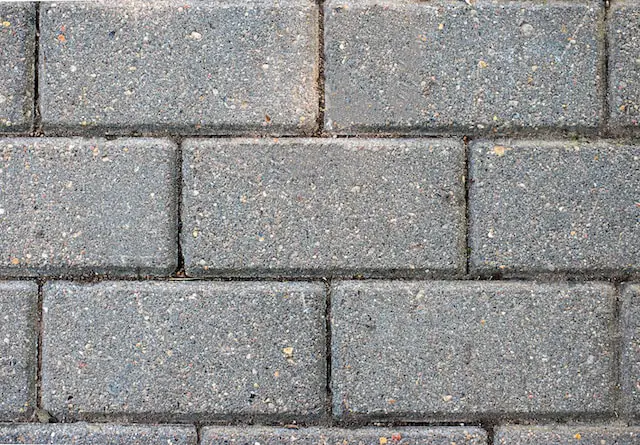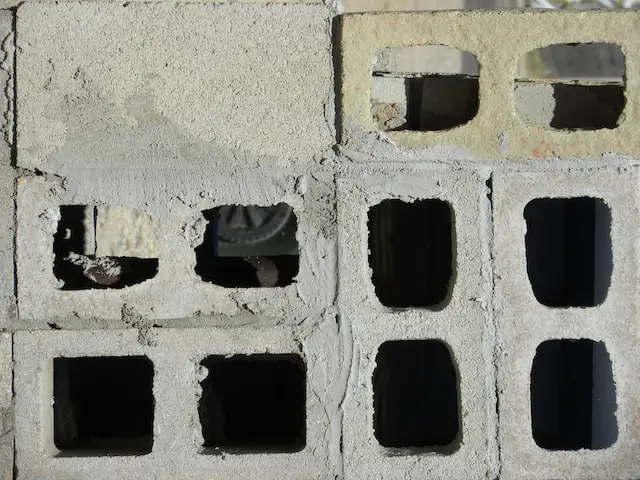Cinder blocks are typically lighter and less dense than concrete blocks, and they are also more porous. Concrete blocks, are much more durable and water-resistant.
What are cinder blocks?
(Photo by Tungsten Rising on Unsplash )

Cinder blocks, also known as concrete masonry units (CMUs), are rectangular blocks made of concrete and coal cinders or ash that are commonly used in construction. They are made by mixing cement, water, and aggregates such as gravel or sand, along with coal cinders or ash. The mixture is then poured into molds and allowed to dry and harden.
Cinder blocks are used in a variety of construction projects, including the construction of walls, foundations, and retaining walls. They are particularly popular in the construction of low-rise buildings and are often used as the primary building material in buildings such as sheds, garages, and basements. They are also used in landscaping projects, such as the construction of garden walls and planters.
Cinder blocks come in a variety of sizes and shapes, including standard 8-inch by 8-inch by 16-inch blocks, as well as half-size and corner blocks. They are also available in different finishes, including smooth and textured finishes.
One of the benefits of using cinder blocks in construction is that they are relatively inexpensive and easy to work with. They are also durable and strong, making them a popular choice for building structures that need to withstand the elements.
However, there are some drawbacks to using cinder blocks. They are not particularly attractive and can be difficult to paint or finish, and they are not particularly energy-efficient, which can lead to higher heating and cooling costs in buildings constructed with cinder blocks. Additionally, cinder blocks are relatively heavy, which can make them difficult to transport and handle during construction.
What are concrete blocks?
(Photo by Sergey Lapunin on Unsplash )

Concrete blocks, also known as concrete masonry units (CMUs), are rectangular blocks made of cement, water, and aggregates such as sand, gravel, or crushed stone. The mixture is then molded into different shapes and sizes and allowed to dry and harden.
Concrete blocks are commonly used in construction projects to build walls, foundations, and retaining walls. They are popular for their durability, strength, and low cost. They can also be used for landscaping projects such as the construction of garden walls, planters, and other decorative features.
One of the benefits of using concrete blocks in construction is that they are versatile and come in many different sizes, shapes, and finishes. They can be smooth or textured, and can even be painted or stained to match the aesthetic of a building or outdoor space. They are also energy-efficient, providing good insulation and reducing heating and cooling costs.
Concrete blocks are generally considered to be more durable than other building materials such as wood, and they are resistant to fire, pests, and weather damage. They are also easy to install and require little maintenance, making them a popular choice for building projects.
However, there are some downsides to using concrete blocks. They can be heavy and difficult to transport and handle during construction, and their production process can be energy-intensive and have a negative impact on the environment. Additionally, they may not be the most aesthetically pleasing option for some building projects.
The benefits and drawbacks of cinder blocks
Cinder blocks, also known as concrete masonry units (CMUs), are a popular building material used in construction projects. Like any building material, there are benefits and drawbacks to using cinder blocks.
Benefits of cinder blocks:
- Durability: Cinder blocks are durable and strong, making them an excellent choice for building structures that need to withstand the elements.
- Cost-effective: Cinder blocks are relatively inexpensive and easy to work with, making them an economical choice for construction projects.
- Versatility: Cinder blocks come in various sizes and shapes, including standard 8-inch by 8-inch by 16-inch blocks, as well as half-size and corner blocks. They are also available in different finishes, including smooth and textured finishes.
- Easy to install: Cinder blocks are easy to install, requiring no special tools or equipment. They are simply stacked on top of each other and secured with mortar.
Drawbacks of cinder blocks:
- Aesthetics: Cinder blocks are not particularly attractive and can be difficult to paint or finish. They are often used in utilitarian construction projects rather than decorative ones.
- Energy efficiency: Cinder blocks are not particularly energy-efficient, which can lead to higher heating and cooling costs in buildings constructed with cinder blocks.
- Heavy weight: Cinder blocks are relatively heavy, which can make them difficult to transport and handle during construction.
- Environmental impact: The production process for cinder blocks can be energy-intensive and have a negative impact on the environment. Cinder blocks made from coal cinders or ash can also release potentially harmful chemicals into the environment.
Cinder blocks are a durable and cost-effective building material, but they may not be the best choice for every construction project. It is important to weigh the benefits and drawbacks of cinder blocks carefully before deciding whether to use them.
The benefits and drawbacks of concrete blocks
Concrete blocks, also known as concrete masonry units (CMUs), are a popular building material used in construction projects. Like any building material, there are benefits and drawbacks to using concrete blocks.
Benefits of concrete blocks:
- Durability: Concrete blocks are durable and strong, making them an excellent choice for building structures that need to withstand the elements.
- Energy-efficient: Concrete blocks provide good insulation, reducing heating and cooling costs in buildings constructed with them.
- Versatility: Concrete blocks come in various sizes and shapes, including standard 8-inch by 8-inch by 16-inch blocks, as well as half-size and corner blocks. They are also available in different finishes, including smooth and textured finishes.
- Easy to install: Concrete blocks are easy to install, requiring no special tools or equipment. They are simply stacked on top of each other and secured with mortar.
- Low maintenance: Concrete blocks require little maintenance, making them a popular choice for building projects.
Drawbacks of concrete blocks:
- Environmental impact: The production process for concrete blocks can be energy-intensive and have a negative impact on the environment.
- Heavy weight: Concrete blocks are relatively heavy, which can make them difficult to transport and handle during construction.
- Aesthetics: Concrete blocks are not particularly attractive and can be difficult to paint or finish. They are often used in utilitarian construction projects rather than decorative ones.
- Cost: Concrete blocks can be more expensive than other building materials such as wood.
Concrete blocks are a durable, energy-efficient, and versatile building material, but they may not be the best choice for every construction project. It is important to weigh the benefits and drawbacks of concrete blocks carefully before deciding whether to use them.
Featured Image By – Debby Urken on Unsplash








